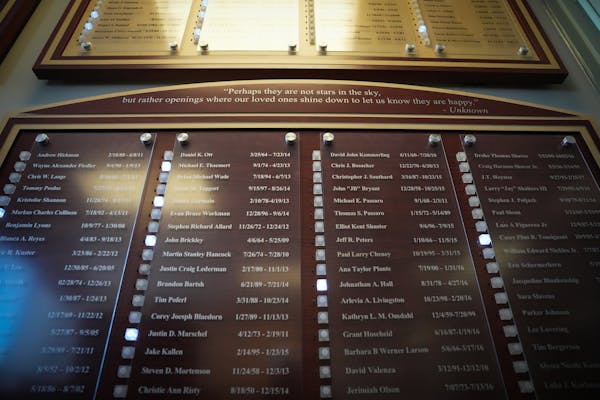How did Brooklyn Center and Brooklyn Park get their names?
Listen and subscribe to our podcast: Via Apple Podcasts | Spotify | Stitcher
A recent trip to visit a friend in the northwestern suburbs rekindled a question that's been on Vince Brown's mind for years:
How did Brooklyn Park and Brooklyn Center get their names? And why are their names similar?
"I've lived here my whole life and I still don't know how to tell them apart and why they're so close together," Brown said. "What is the history behind that?"
Brown sent his question to Curious Minnesota — a Star Tribune community-driven reporting project that puts readers' inquiries at the center of the newsroom's reporting.
These two suburbs are often confused for one another. But they have some key geographic distinctions. Brooklyn Park is considerably larger in size and population. Its borders partly surround Brooklyn Center, which adjoins north Minneapolis.
The cities' history starts with Indigenous people who lived on Minnesota land long before the first settlers of European descent arrived.
People have lived in the area that became Minnesota for at least 9,000 to 12,000 years, according to the Minnesota Historical Society. The Dakota and Ojibwe tribes made up most of the state's population by the 1600s.
Dakota people lost their rights to land in much of the Twin Cities area in two 1851 treaties with the U.S. government. This opened the way for white settlers to claim land in what would become Brooklyn Center and Brooklyn Park starting in 1852, according to "The Brooklyns," a book by the Brooklyn Historical Society that chronicles the history of the area.
"Life for the average new-settler family was not easy," the book stated. "Some had small cabins with, occasionally, a leaky roof, and they had to cook and heat with wood-burning stoves. Toilets were outside, as well as their water supply, in the form of hand pumps or wells."
Early settlers in the area worked hard as fur traders and farmers, according to "The Brooklyns." They grew and harvested food including sweet corn, wheat, potatoes, asparagus, strawberries and pumpkins.
Naming the town
In 1853, Allen B. Chaffee led 14 families from Adrian, Mich., to the area. The families named their new home after Brooklyn, Mich., a township near Adrian that got its moniker from a local minister who hailed from New York.
The New York Historical Society says the Brooklyn borough's name refers to a village in the Netherlands called Breukelen.
Brooklyn Township in Minnesota was officially recognized after statehood in 1858. It covered a broad area that includes the two present-day suburbs.
The new settlers faced much hardship. Esther Crooker's family lived through droughts, grasshopper plagues and other troubles after moving to Brooklyn Center before the Civil War, according to a 1932 Minneapolis Journal article commemorating her 100th birthday.
"Depression? [P]eople now don't know what it is to have hard times," Crooker said, referring to the Great Depression. "Get out on a prairie in the wintertime, in a little rude house with the wind blowing through it, with only the remnants of a crop failure to see you through the winter, miles away from everybody, and you'll know what hard times really are."
Fears of annexation would ultimately prompt both the Brooklyns to incorporate as villages, though four decades apart.
Accommodating rapid growth
The cities of Minneapolis and Osseo were growing, and cities could annex land from nearby unincorporated townships. Residents met in Earle Brown's garage in 1911 to vote in favor of turning Brooklyn Center into a village, bringing road repair, traffic laws and electricity to the area.
It was among many townships near Minneapolis that incorporated in the early 1900s to avoid being annexed.
Brown later earned notoriety as a "booze-busting" sheriff during Prohibition, making an unsuccessful run for governor in 1932. A street and heritage center were later named in his honor. But city officials recently removed his name from the center after a book alleged that Brown was a member of the Ku Klux Klan and vice president of the Minnesota Eugenics Society.
Brooklyn Township became Brooklyn Park when it incorporated as a village in 1954 in order to "hold onto the present size of the township and prevent it from being annexed by land-hungry neighboring villages," according to the Minneapolis Star.
The post-war suburban boom brought thousands of new residents to both areas in the 1950s. Brooklyn Center and Brooklyn Park became cities in 1966 and 1969, respectively, according to "The Brooklyns."
Brooklyn Center's population of roughly 33,000 people is slightly lower today than it was in 1970, according to the Metropolitan Council. Brooklyn Park's population, by contrast, has more than tripled since 1970 to upwards of 86,000 people today.
If you'd like to submit a Curious Minnesota question, fill out the form below:
Read more Curious Minnesota stories:
How did Dinkytown in Minneapolis get its name?
Why do tiny cities like Lauderdale, Landfall, Lilydale, & Falcon Heights exist?
Where did streetcars once travel in the Twin Cities suburbs?
What does 'Minnesota' mean and how did the state get its name?
Why is St. Paul located where it is? Hint: It involves liquor
Why didn't Minneapolis gobble up its suburbs?




